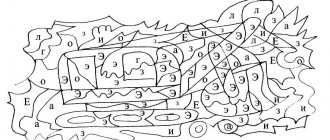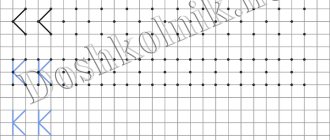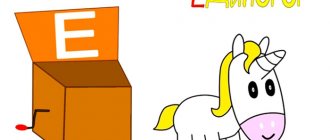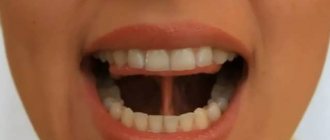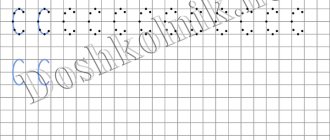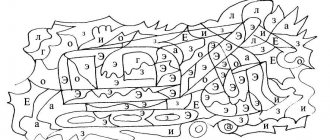Everything to create conditions for the formation of the skill of confident differentiation of paired consonants “v-f”. A large selection of exercises to develop the ability to clearly and correctly pronounce isolated sounds [v]-[f], onomatopoeic words with these sounds. Ready-to-use lesson notes and educational activities for the development of phonemic perception of these paired consonants. Homemade games and didactic materials for organizing articulatory gymnastics, comparative characteristics of sounds [v]-[f]; their differentiation in sentences. We hear and distinguish: either the cat Foka will snort on the roof, or the Wolf will howl in the forest.
V - F: pronunciation, differentiation, literacy training
Contained in sections:
- Letters. Getting to know letters and sounds 2733
Showing publications 1-10 of 190. All sections | Letters V, F and sounds [V], [F]. Class notes
New
Photo
The best
Lesson summary on sound automation “Sound [V]” Sound Bb Practical material on sound automation Bb 1 . Repeat the syllables. Vya - vya - vya Vya - veo - vu - viu Vu - vu - vu Be - vu - vi - vya Be - ve - ve Vyo - ve - vi - vu Vi - vi - vi Veau - vu - vya - vi Vyo - vyo - vyo Vyu - vya - vi - vyo 2. Repeat the words. Sound at the beginning of a word : Elm,...
Summary of a literacy lesson “Sounds [F, F'], letter F” Topic: Sounds [f , f], letter F. Goal: to introduce children to the sounds [f , f] and letter F. Objectives: Educational: • introduce children to the graphic image of the letter F ; • develop the ability to distinguish the letter F among other letters ; • improve the skill of reading syllables and words with the letter F ; •…
Sound F
Articulation of the F sound: the lower lip is slightly retracted and pressed against the upper teeth, the upper lip is slightly raised. The upper teeth are visible. The exhaled air breaks into the gap between the upper teeth and lower lip. The vocal cords are resting, the throat is not trembling (no voice) Staging sound F: 1st method: by imitation. When pronouncing a sound, the speech therapist draws the child’s attention to the position of his lips. The child sees how the lower lip is pulled towards the upper incisors, and the upper one rises. Method 2: if the child cannot immediately place his lips in the proper position, you need to invite him to blow, bringing the upper and lower lips closer together. At this moment, the speech therapist lifts the child’s upper lip with his finger, then the lower lip reflexively rises to the upper incisors. The result will be the sound F. Method 3: the speech therapist lifts the child’s lower lip with two fingers to the upper incisors, using this technique until the child has strengthened the skill of independently pulling the lower lip upward. (Material taken from the book by M. Polyakova “Self-instruction manual on speech therapy. A universal manual”) 4.1. Let the child bite his lower lip a little with his upper incisors and in this position blow air out of his mouth. The exhalation should be felt on the palm placed below the mouth; it should also be felt on the lower lip and upper teeth. The sound [f] will be heard. Make sure that the child’s lips are not tense, so that he does not “wrinkle” them. The upper lip should be raised. 4.2. Draw the child’s attention to the sound he makes, name it ([f]). 4.3. Then (keeping the same position of the speech organs) proceed to pronouncing the syllables [fa - fa - fa] and syllables with other vowel sounds. Syllables can be pronounced by imitation. 4.4. In the future, let the child not bite his lip, but simply touch it with his teeth (to its inner surface). Articulation of the sound Фь: Almost like the sound F. The difference is that when pronouncing the sound Фь the lower lip is less tense. Setting the sound Fb. By imitation. Best in the syllable FI. Gradually, the sound I is pronounced more briefly and dullly, resulting in the sound Fь.
Speech therapy manual “Name the pictures.” The F sound (Funtik) is aimed at automating the F sound in words (the F sound at the beginning of a word). Promotes automation of reading skills, development of attention and memory. Enriches and activates the child's vocabulary. The manual is intended for children of senior preschool or primary school age. The material consists of 58 sheets. They contain 54 cards with pictures, title pages, annotations and an algorithm for working with the manual. It is recommended to print on photo paper, image size A6. File in PDF format. Speech therapy manual “Name the pictures.” Sound F. (Funtik) – 70 rubles.
Payment information here.
Speech therapy manual “Name the pictures.” The F. sound (Roquefort) is aimed at automating the F sound in words (the F sound in the middle of a word). Promotes automation of reading skills, development of attention and memory. Enriches and activates the child's vocabulary. The manual is intended for children of senior preschool or primary school age. The material consists of 34 sheets. They contain 30 cards with pictures, title pages, annotations and an algorithm for working with the manual. It is recommended to print on photo paper, image size A6. File in PDF format. Speech therapy manual “Name the pictures.” Sound F. (Roquefort) - 50 rubles.
Payment information here.
Speech therapy manual “Name the pictures.” The F sound (Kif) is aimed at automating the F sound in words (the F sound at the end of a word). Promotes automation of reading skills, development of attention and memory. Enriches and activates the child's vocabulary. The manual is intended for children of senior preschool or primary school age. The material consists of 23 sheets. They contain 19 cards with pictures, title pages, annotations and an algorithm for working with the manual. It is recommended to print on photo paper, image size A6. File in PDF format. Speech therapy manual “Name the pictures.” Sound F. (Kif) - 50 rubles.
Payment information here.
Speech therapy manual “Name the pictures.” The sound Фь (Filin) is aimed at automating the sound Фь in words (the sound Фь at the beginning of a word). Promotes automation of reading skills, development of attention and memory. Enriches and activates the child's vocabulary. The manual is intended for children of senior preschool or primary school age. The material consists of 24 sheets. They contain 20 cards with pictures, title pages, annotations and an algorithm for working with the manual. It is recommended to print on photo paper, image size A6. File in PDF format. Speech therapy manual “Name the pictures.” Sound FH. (Filin) - 50 rubles.
Payment information here.
The album for children “Automation of the F sound” is aimed at reinforcing the correct pronunciation of the F sound in words, phrases, sentences and poems. Promotes the development of attention and memory. Enriches and activates the child's vocabulary. The manual is intended for children of senior preschool or primary school age. The notebook has 23 sheets with various tasks and picture material. It is recommended that you print and staple the sheets in a binder. File in PDF format.
The cost of the Album for children “Automation of sound F” is 230 rubles.
Payment information here.
Preparation for literacy training “Introduction to the sound [f'] and the letter F”
Summary of organized educational activities with children 5-6 years old: Preparation for teaching literacy “Introduction to the sound [f
'] and the letter F.”
Compiled by: teacher Somova N.N.
Tasks:
—
introduce children to the sound [f'];
- fix the image of the letter F;
- to develop the ability to differentiate the sounds [f] and [f'] by hardness - softness,
determine the place of new sounds in words; correct articulation of sounds [f] and [f'];
- develop phonemic awareness, attention, coherent speech, logical thinking, and the ability to work in a team;
— to cultivate interest in learning literacy and reading, a sense of camaraderie, independence, and discipline.
Progress of
GCD
I. Organizational moment
(creating a favorable atmosphere; imaginary situation to stimulate interest and emotional state).
- Let's smile at each other.
- Now we will go on a journey.
-Where are we going? (To the magical Land of sounds and letters).
On the desk:
— How do sounds differ from letters? (We hear sounds /children point to their ears/ and pronounce them /on their lips/, we see letters /on their eyes/, read /palms in front of us - imitation of a book/ and write /write with their hand in the air/.)
- What will we do in the Land of Sounds and Letters? (Get to know new sounds, letters and play with them).
— We close our eyes and teleport.
II.
Introducing the sound [f'].
- Open our eyes. So, we are in the Land of Sounds and Letters.
1. Speech game
for the development of auditory attention “Zvukoezhka” .
— The sound-eater flew in, and he ate the sounds in the words.
- I will pronounce the word without the last sound, and you will pronounce it correctly.
Fat...(ph), shka...(ph), ball...(ph).
- What sound did the Sound Eater eat? (f sound).
Characteristics of sound according to the diagram.
- What do we know about the sound [f]? (consonant, voiceless, hard).
— The sound [f] has a brother. He is affectionate and kind. What's his name? (sound [f'])
2.Work on the correct articulation of the sounds [f] and [f'].
- Let's say [f'] in unison. Sound [f'] - what is it? (consonant). Prove (does not sing, the air stream meets an obstacle, the upper teeth lightly touch the lower lip).
- Voiced or voiceless?
Children cover their ears with their palms and pronounce the sound [f']. (the sound is noisy, which means it is deaf)
— Hard or soft? (we seem to be smiling, it means soft).
- Repeat what we learned about the sound [f']. What is he like? (consonant, voiceless, soft)
- What sounds do you think we will play with? (with sounds [f] and [f'])
-Let’s clearly pronounce the sound [f]: the upper teeth lightly touch the lower lip.
- Let's clearly pronounce the sound [f']: lips in a smile, teeth lightly touching the lower lip.
III. Consolidation of new knowledge.
1.
Game “Signalers”
(differentiation of sounds [f], [f'])
-Can you tell the brothers apart from each other?
- I make sounds, you light the lights ([f], [f'], [f'], [f], [f']).
- And now, on the contrary, I light a light, and the one I point to pronounces the sound [f] or [f'].
Problematic question.
- Look, you still have a red light. Why wasn't it lit? (red color indicates vowel sounds)
2.
Game “Sound nesting dolls” ( differentiation of sounds [f], [f'], formation of the skill of sound analysis (determining the place of a sound in a word):
- Have you learned to distinguish brothers? (Yes)
- So, we can play with the Sound Matryoshka dolls.
- Close your eyes. (the teacher places the “Sound Apple Tree” and “Sound Matryoshka Dolls” on the board)
-We will pick apples and... (the children continue in unison) Treat the nesting dolls.
- Do the Matryoshkas eat all the apples? (No, with a blue apron - apples with a picture in the title of which the sound [f], with a green apron - the sound [f']).
- On the cards, mark the place of the sound in the word with a blue or green apple.
On the cards, children indicate the place of the sound in the word with a blue or green circle (apple).
- What is written on the apple? (owl) Which Matryoshka do we treat? (With a green apron) Why? (sound [f'] – soft)
- Determine the place of the sound in the word. Where do we hear the sound: at the beginning, in the middle or at the end? (At first)
- Mark the location of the sound on the card with an apple.
(Words: flamingo, fairy, candy, candy wrapper, cap, giraffe, fireworks, bucket, shark)
-Look, there are 2 apples left. Why? (Bucket, shark - there are no sounds [f] and [f'].)
Physical education (children stand up and draw the letters m, zh, s in pairs): o, m, x, t, s, g, s, k, zh.
VI. Introducing the image of the letter F.
— The sounds [f] and [f'] are denoted by one letter. This is the letter “ef”, but we will call it like the sound [f].
- Let's repeat [f].
- Find and show the letter F on the poster.
-What does she look like?
Exercises to consolidate the image of a new letter: “Living ABC” (children depict a letter)
:
The letter F puffed out its cheeks
Or put your hands on your hips.
- Close your eyes. Open. What has changed on the board? (the letter F appears)
- Look, is everything okay with the letter? (no, it is not colored, it is transparent)
— It rained and washed away all the paint from our letter. What color was she? (Half is blue, half is green) Why?
- Let's help the letter become its former self.
Children color the letter in their notebooks.
Vocabulary work with the words “pheasant, carp”: Game “Cryptographers”
CIRCLE – F
OVAL - W
ROMB – N
RECTANGLE – A
SQUARE – A
- Read the word.
- Who or what is a pheasant? (Bird) (ON THE BOARD OF FIGURE 1, see appendix)
- Look, suddenly the bird turned into a fish. (ON THE BOARD OF PICTURE 2, see Appendix)
- There was a pheasant, but it became...? (carp).
- What happened to the word “pheasant”? (The letter F was replaced by the letter C)
- And the bird became a fish.
“That’s how important it is to know the letters and write them correctly.” And what might begin? (Confusion)
V. Summary
- It's time for us to go to our kindergarten.
— We close our eyes and teleport.
- Open our eyes. So we're in our group.
— Did you like it in the Land of Sounds and Letters? What did you like more?
– What sounds did you become familiar with? How are they similar? What is the difference?
Formation of self-analysis skills in children.
— What was difficult?
Application
Picture 1.
Figure 2.
Tale about the letter F
Magician Fedya
A huge plywood poster appeared in the forest, on which it was written:
“Hurry to see! The pheasant magician uses a magic lantern to transform a ficus into a violet! A fountain from an empty bottle! Instant photography without a camera!
“Hey,” said Fedya the owl, “everyone can do it with a magic lantern.” But I’ll show you the same tricks without a flashlight. Who has a ficus? “I have it,” said the bear and brought a ficus in a pot. - Put it on the stump and give me your apron here!
Fedya covered the ficus with an apron and whispered loudly:
- Fabes, mabes, stick, ficus, become a violet! - then as soon as the apron is pulled off, the ficus crashes to the ground! The pot is in pieces, the ficus is in half. - Do you know what I’ll do to you for this trick? - the bear roared. - Learn first, and then show tricks, half-educated fakir!..
(G. Yudin)
Funny poems about the letter F for children
... And the pheasants asked - Find us the letter F, Owl. But, sighing heavily. An eagle owl hides in a hollow. An eagle owl, even with a flashlight, sees nothing during the day. (G. Satir)
Owl in the bowl wow wow wow! The bunny's spirit froze. The poor little bunny didn't sleep, he trembled under the bush all night. (F. Bobylev)
Violets - Ew, whew! - the bird sings. And the violet blooms, And the earth looks at us with a million blue eyes. (G. Vieru)
The magician is dressed in a tailcoat, the torch will turn into a bouquet, the fairy will jump out of there. Is it a trick or a miracle? (V. Berestov)
The owl took the soccer ball, And at the new minks, a football match began between two teams of new ones. (A. Pudval)
The owl is gray, the owl is old, And the eyes burn like headlights. Owl - jump, eagle owl - hop, Filinenka gave a flag. Little Owl is glad, glad - Two lanterns are burning. (G. Satir)
Checkbox Look! Look! That's the flag Mitya has! Who gave the flag? Mitya made it himself. (O. Vysotskaya)
Photographer It's not easy to photograph animals. The hare asks: “Hurry up!” The mouse squeaks: “I’m a little afraid that the cat will see the picture.” “I’ll prick you,” the hedgehog threatens, “if you don’t send me a picture!” (V. Berestov)
